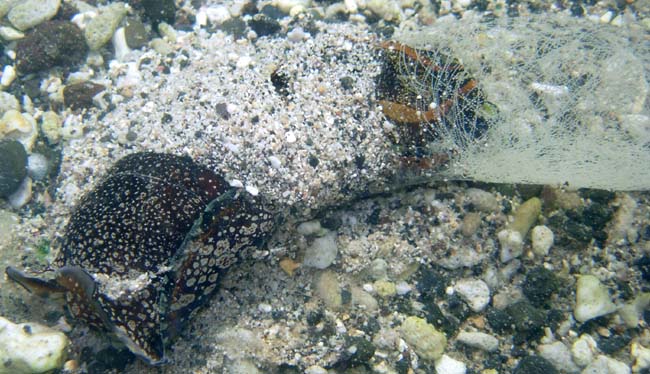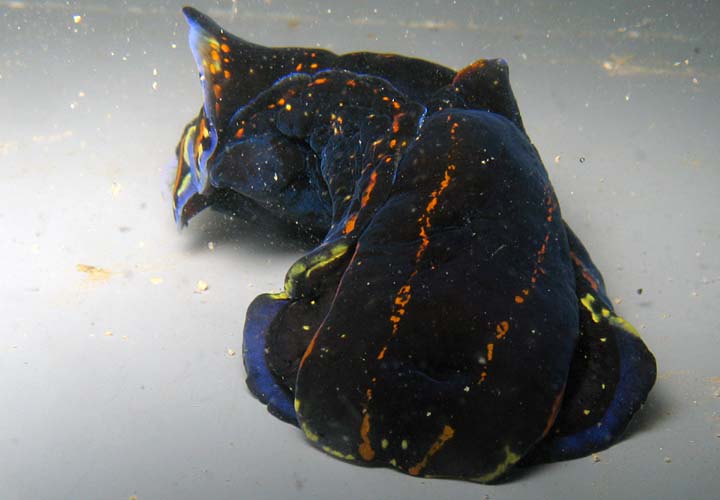This species has been observed on Reunion, Mauritius, Mayotte and Madagascar Islands
The head shield, which has its posterior margin raised into a tapering crest which stands erect, is shorter than the posterior shield. The posterior shield ends in two rounded lobes of equal length, but very short compared to Chelidonura The background colour varies from light brown to almost black with blue, white, yellow or brownish-yellow markings and there are often dull orange, longitudinal stripes on the head shield. |
 |
|
| Showing species characteristics... | Photo Philibert Bidgrain |
|
See more about : Sightening and mating periods
See more about : Philinopsis speciosa variability in Southwest Indian ocean
See more about : Spawn and mating events in Philinopsis speciosa
Remarks :
Identification confirmed by Bill Rudman and Nathalie Yonow
Synonymous : (according Worms)
- Aglaja cyanea (Martens, 1879) - Philinopsis cyanea (Martens, 1879)
- Doridium cyaneum Martens, 1879
Bibliographic data :
They have huge mucus glands around the head which produce a cylinder of mucus through which they crawl when burrowing through sand or mud.
Juvenile animals are often more colourful than adults.
The Aglajidae are all carnivorous hunters, and species of Philinopsis are usually found burrowing in sand or sandy mud. The species of the genus Philinopsis can be divided into two groups.
-"Philinopsis taronga group" (ex : P speciosa), have a large partially eversible buccal bulb. They use the buccal bulb to catch the bubble shells and other opisthobranchs.
-In "Philinopsis pilsbryi group" (ex P gardineri), the buccal bulb is a long muscular tube. It is possible that they use the buccal bulb as a long eversible tube which can catch prey (worms?) in narrow burrows or crevices. Species with this foregut are usually quite easy to identify in the living animal as the folds of the tube form a rounded central crest on the head
They feed by partially everting their large eversible muscular buccal bulb, to envelop their prey which they swallow whole.
After digestion, the empty, unbroken shell of the prey is regurgitated, being too large to pass through the gut.
These spevies feeds on other bubble shells, such as Bulla, Atys and Haminoea, and may be Stylocheilus striatus... They track their prey by using its chemoreceptors to follow the mucus trail of its victims.
The penial sac is on the anterior right corner of the head, the penis only extending out of the sac during mating. Sperm reaches the penis in a ciliated groove running along the right side of the body from the common genital opening.
The common male & female genital opening is at the back of the body on the right side, on the floor of the reduced mantle cavity.
As in the Sea Hares (Anaspidea), aglajids mate "head to tail" the anterior one acting as female and the posterior one as male.
Some colour form of P. speciosa has similarities to P. gardineri but that species has a round (high rounded bump on the head) rather than truncate anterior end of the body.
There is also similarities with P.taronga, but in P. speciosa there are either two orange/yellow lines on the head or traces of them, while in P. taronga there is a single median line or traces of it.
References :
Bill Rudman Seaslug site : Sea Slug Forum : Philinopsis cyanea
Nudipixel Philinopsis cyanea
Publications :
Pease W.H. (1860). Descriptions of new species of Mollusca from the Sandwich Islands. Proceedings of the Zoological Society of London. 28: 18-36, 141-148.
Rudman,W.B., 1972. A comparative study of the genus Philinopsis Pease, 1860 (Aglajidae, Opisthobranchia). Pacific Science, 26 : 381-399
Rudman,W.B., 1972. Structure and functioning of the gut in the Bullomorpha (Opisthobranchia). Journal of Natural History, 6 : 547-560.
Gosliner,T. M., 1980. Systematics and phylogeny of the Aglajidae (Opistobranchia : Mollusca). Zoological Journal of the Linnean Society, 68 : 325-360
Other photos of Philinopsis speciosa :
Chritophe Cadet Reunion, Dead specimen found in December 2010 The internal gills (a)
Below: The mouth wide open |
 |
 |
|
Philibert Bidgrain This spawning event was observed in a pool at "Kélonia center" a Marine Turtle Center in Saint Leu, Réunion Three very big specimens (130 to 140 mm) of this species produced a lot of spawns for several days According Bill Rudman : "Apparently they wrap the egg string around their body, coating it with mucus, and gradually pushing it off the head end, forming the characteristic sausage-shaped structure."
|
 |
 |
Each spawn consists in a long (length from 10 to 20 cm) jellylike tube on whose surface a long chain of white egg mass can be observed  |
|
|
(X 20) : Detail of the spawn, showing the "chain of white egg mass". |
(X 100) : Each egg mass contains 20-30 eggs in the same capsule.The different capsules are connected by a thin filament (chalaza). |
 |
 |
Philibert Bidgrain This mating behaviour was observed in a pool at "Kélonia center" a Marine Turtle Center in Saint Leu, Réunion 15 November 2005. |
 |
 |
Philibert Bidgrain This specimen was observed in a pool at "Kélonia center" a Marine Turtle Center in Saint Leu, Réunion 18 November 2005, size : 130 mm. A specimen with light brown background colour. |
Florence Trentin Saint Leu lagoon, Réunion, crawling on the substrate during the night, 26 November 2007, size : 25 and 50 mm A wonderfull illustration of background colour variability on this species.
|
 |
 |
Alain Barrère
Etang salé les bains lagoon, Réunion, crawling on the substrate during the night, 24 November 2007 The head shield, which has its posterior margin raised into a tapering crest which stands erect.
|
Lucie Maillot This specimen was observed in a pool at "Kélonia center" a Marine Turtle Center in Saint Leu, Réunion 15 April 2009, size : 45 mm. Another pattern with many little dull orange spot in place of longitudinal stripes on the head shield |
 |
 |
Sylvain Le Bris Mayotte, 6 December 2008 The white spots are well develloped in this specimen. |
Philibert Bidgrain Reunion, Saint Gilles lagoon, less 1 m, 26 November 2010, size : 90-100 mm During the night, actively crawling on a seagrass meadow.
|
 |
More photos from Indian Ocean
See more about : Philinopsis speciosa variability in Southwest Indian ocean
See more about : Spawn and mating events in Philinopsis speciosa
Reunion Island, Philinopsis cyanea in seagrass meadow, at Saint Gilles, by Philibert Bidgrain
Reunion, Phylinopsis cyanea without orange lines, at Etang salé, by Sonia Ribes-Beaudemoulin
Reunion, Philinopsis cyanea during he night, at Etang salé, by Alain Barrére
Reunion, P. cyanea, from the rocky coast of Etang salé, by Hugues Flodrops
Reunion, a black form of P. cyanea, at Etang salé, by Hugues Flodrops
Mayotte, Philinopsis cyanea with dull orange longitudinal stripes, by Sylvain Le Bris
Réunion, Philinopsis cyanea looks like P. reticulata, at Saint Leu, by Florence Trentin
Reunion, détail of Philinopsis cyanea tapering crest , at La Saline, by Philippe Bourjon
Mauritius, Philinopsis cyanea, at Tamarin, by Hilary Jones
Madagascar, Philinopsis cyanea, at Nosy Bé, by Alain-Benoît Rassat
